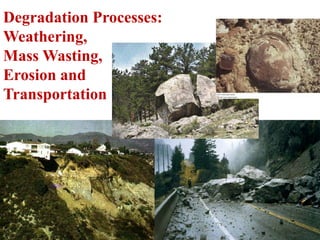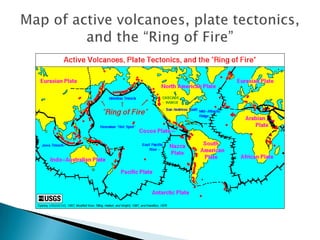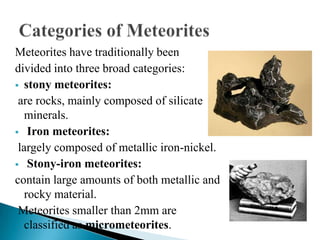glacier
- 4. Geomorphic processes: All the processes including physical and chemical changes which effect or modify the earth’s sufficial form are called Geomorphic processes.
- 5. Geomorphic Agents: “A geomorphic agent is any medium, which is enable of securing and transporting earth materials”. Thus running water including both concentrated and unconcentrated run-off, groundwater, glaciers, wind and movements within bodies of standing water including waves, currents, and tides fall in this group.
- 6. Most of the geomorphic agents originate within the earth’s atmosphere. And are also directed by the force of gravity. Gravity is not a geomorphic agent because it cannot secure and carry away materials. It is better thought of as a directional force.
- 7. 1 2 3 • Epigene or exogenetic process • Hypogene or endogenetic process • Extraterrestial
- 8. Exogenetic processes are those processes which originate and modify the earth’s crust from the outside but within the atmosphere. This process functioned by Gradation. Gradation: The process by which the earth's surface irregularities are removed and a level surface is created, is known as gradation. All gradation-processes are directed by gravity. The processes of gradation are divisible into two major categories Degradation and Aggradation.
- 9. Degradation : is the process in which material from the high lands are removed by the geomorphic agents as a result of which the altitude of the highlands are reduced. Degradation of the earth's surface is mainly carried out through : (a) Weathering, (b) Mass-wasting (c) Erosion and Transportation
- 10. Degradation Processes: Weathering, Mass Wasting, Erosion and Transportation
- 11. Relationship: Weathering, Mass Wasting, Erosion and Transportation Together, these processes are responsible for Denudation of Earth’s surface
- 12. Various Geomorphic Agents, associated Processes, and resulting Erosional Features 1.Fluvial Process or features made by river: Perennial streams and entrenched channels V-shape valleys Rapids potholes waterfalls plunge pools Alluvial terraces meandering streams bank erosion Oxbow lakes Delta etc.
- 13. 2.Features made by Glaciers: Cirque Tarn Horn Aretes U-shaped valleys hanging valleys Stratiations glacial lakes.etc
- 14. 3.Erosional features made by Wind: Mashroom rock Earth piller deflation hollows Zeugen Yardang Inselberg Desert pavement Inkanter & driekanter
- 15. Aggradation: is the process of deposition of sediments. As we know, under favourable conditions, when the transporting agents lose their carrying power, the transported materials get deposited, sometimes in the sea, sometimes on the land. Thus the low lying tracts are gradually filled up through deposition of sediments by running water, ground water, wind, glaciers, wave, currents, tides in seas, oceans etc.
- 16. • Various geomorphic agents, associated processes and resulting Depositional Features Rivers: Braided streams sand bars Floodplains (alluvium deposits) Natural levees Distributaries deltas Alluvial fans & bajadas.etc
- 17. Eolian Features: Loess Sand dunes (Barchans, Parabolic, Transverse, Longitudinal, Star dunes) Glacial features: Moraines (lateral, medial, end, terminal, and ground moraines) Till plains Kettles Outwash plains Drumlins Eskers Kames & Erratic
- 18. These are also known as hypogene processes. These are the processes of internal origin. In other words, a process which originates within the earth's crust is termed endogenetic process. Endogenetic processes can consist of anything from plate tectonics, earth quakes, and volcanic activities. Endogenetic processes occurs so slowly that it is very rare to find an unmodified landform.
- 19. Endogenetic processes are of two types 1.Volcanism 2.Tectonic Processes (Also called Diastrophism)
- 20. Volcanism/ Volcanicity : It is the phenomenon in which matter is transferred from the earth's interior and erupted onto its surface. It is one of the important manifestations of the dynamic nature of the earth. The process of effusion of magmatic material on to the surface of the earth, thus forming various volcanic structures and flowing over the surface, is called volcanism. Magma beneath the crust is under very great pressure. When folding and faulting occur, cracks or fractures which are lines of weakness. When these lines of weakness develop downward in the crust and reach the magma, they will release the pressure in the magma. This allows magma to rise up along the lines of weakness and intrude into the crust. Some magma may even reach the earth's surface.
- 21. There are two types of volcanic activities according to their mode of occurrence. Intrusive volcanism Extrusive volcanism Intrusive volcanism: When magma solidifies below the earth’s surface it produces igneous rock. If this rock is pushed upward into the crust either before or after solidification, it is called “igneous intrusion”. The intrusive process is usually a disturbing one for Pre-existing rock.
- 22. The most common types of intrusive volcanoes are: Batholith Laccolith Lopolith Sill Dike
- 23. Molten magma extruded on to the surface of the earth, where it cools and solidifies is known as “lava". The ejection of lava into the open air is sometimes volcanic and explosive,devasting the area for miles around. In other cases, it is gentle and quite, affecting the landscape more gradually. The extrusive volcanism is primarily associated with two major landform: Volcanoes Lava flows
- 24. There are three types of volcanoes by activity Active or Live volcanoes Dormant volcanoes Extinct volcanoes
- 25. An active volcano is one that has erupted in recorded history and they’re probably going to erupt again soon. Throughout the world there are 500 to 800 active volcanoes, lie mostly along cirum-pacific belt or commonly known as the “Ring of Fire.”
- 26. S.no Name Country Year of Activity 1 Kilauea Hawaii 1823, 1987 2 Stromboli Italy 1768, 1952 3 Mt.St.helens USA 1800,1887,1980 4 Volcano Italy 1890 5 Karakatua Sumatra, Indonesia 1680,1969 6 Mauna Loa Hawaii 1859, 1950 7 Mayon philiphines 1616, 1984 8 vesuvius Italy 1979,1906 9 Hekla Iceland 1693, 1970
- 28. A dormant volcano has been quite for sometimes, but can be erupted within recorded history, and is consider to be potentially active. Such dormant volcano shows evidence of recent history.
- 29. A volcano that has not been known to erupt at any time, since its discovery is considered to be extinct. Some old volcanoes notably California’s Mount Shasta and Washington’s mount baker have not erupted in recorded time and are considered extinct volcanoes.
- 30. Diastrophism : “Deformation of the earth’s crust due to folding and faulting.” Diastrophic forces elevate or build up portion of earth’s crust. Diastrophic processes: There are two types of Diastrophic processes: Orogenic Eperogenic
- 31. Orogenic Processes: Mountain building processes that occur from compressional forces that are generated by continued subduction or the trapping and deformation of sediment and crust between two colliding plates.
- 32. Epeirogenic Processes: Processes that cause uplift or depression on a regional scale and proceed without internal disruption of original rock surfaces. It occurs in response to driving forces.
- 33. Orogenic Processes It makes Mountains Local movement They are small scale They are episodic Epeirogenic Processes It makes plateau Regional Movements They are large scale They occur at once
- 34. Folding: Folding is one of the endogenetic processes. When two forces push towards each other from opposite sides, the rock layers will bend into folds. The process by which folds are formed are due to compressional forces known as folding. There are large-scale and small-scale folds. Large-scale folds are found mainly along destructive plate boundaries. There are three types of folds: Monocline Syncline Anticline
- 35. Monoclines: Are the simplest types of folds. Monoclines occur when horizontal strata are bent upward so that the two limbs of the fold are still horizontal In monocline Pressure exert from one side
- 36. Anticlines Folds: Anticlines are folds where the originally horizontal strata has been folded upward, and the two limbs of the fold dip away from the hinge of the fold. Fold mountains are formed when the crust is pushed up as tectonic plates collide. When formed, these mountains are usually enormous like the newly formed Rocky Mountains in Western Canada and the United States
- 37. Syncline: A syncline is similar to an anticline, in that it is formed by the compression of a tectonic plate. However, a syncline occurs when the plate bends in a downward motion. The lowest part of the syncline is known as the trough. Synclines are formed when pressure exert from both sides. Synclines and anticlines usually occur together such that the limb of a syncline is also the limb of an anticline. The lowest part of the syncline is known as the trough.
- 38. Faulting: A fault is when tension and compression associated with plate movement is so great that blocks of rock fracture or break apart. This process can occur very rapidly, in the form of earthquakes. The damage caused by this event can be very destructive and cause severe changes to the earths surface.
- 39. Faults can be divided into several different types depending on the direction of relative displacement. There are three types of fault which are caused by different endogenetic forces: Normal fault strike slip fault Oblique slip fault Faulting forms two major landforms block mountains and rift valleys.
- 40. This occurs when rocks move away from each other due to the land moving apart. When the rocks move apart, the side with the less stable tectonic plate drops below the side with the more stable plate.
- 41. Are faults where the relative motion on the fault has taken place along a horizontal direction. Such faults result from shear stresses acting in the crust. Strike slip faults can be of two varieties, depending on the sense of displacement. To an observer standing on one side of the fault and looking across the fault, if the block on the other side has moved to the left, we say that the fault is a left-lateral strike-slip fault. If the block on the other side has moved to the right, we say that the fault is a right-lateral strikeslip fault.
- 42. When the hanging wall motion is neither dominantly vertical nor horizontal, the motion is called oblique-slip. Although oblique faulting isn't unusual, it is less common than the normal and strike-slip movement.
- 43. The processes which are acting away from the surface of the Earth are called Extraterrestrial processes. Extraterrestrial processes include Meteorides. The topographic effect of the impact of meteorites(piece of rock or metal that has reached the earth’s surface from outer space) do not fall within either of the above classes and are termed extraterrestrial, which mean from beyond the limits of the earth’s domain. In October 2011, scientists reported that one form of extraterrestrial material is cosmic dust which contains complex organic matter that could be created naturally, and rapidly, by stars.
- 44. A meteorite is a meteoroid (a solid piece of debris from such sources as asteroids or comets) originating in outer space that survives impact with the Earth's surface. A meteorite's size can range from small to extremely large. Most meteorites derive from small astronomical objects called meteoroids, but they are also sometimes produced by impacts of asteroids. When a meteoroid enters the atmosphere, frictional, pressure, and chemical interactions with the atmospheric gasses cause the body to heat up and emit light, thus forming a fireball, also known as a shooting/falling star. More generally, a meteorite on the surface of any celestial body is a natural object that has come from elsewhere in space. Meteorites have been found on the Moon and Mars.
- 45. Meteorites have traditionally been divided into three broad categories: stony meteorites: are rocks, mainly composed of silicate minerals. Iron meteorites: largely composed of metallic iron-nickel. Stony-iron meteorites: contain large amounts of both metallic and rocky material. Meteorites smaller than 2mm are classified as micrometeorites.
- 46. Most meteoroids disintegrate when entering Earth's atmosphere. However, an estimated 500 meteorites ranging in size from marbles to basketballs or larger do reach the surface each year only 5 or 6 of these are typically recovered and made known to scientists. Few meteorites are large enough to create large impact craters. Instead, they typically arrive at the surface at their terminal velocity and create a small pit. Even so, falling meteorites have reportedly caused damage to property, and injuries to livestock and people.
- 47. Until the 20th century, only a few hundred meteorite finds had ever been discovered. Over 80% of these were iron and stony-iron meteorites, which are easily distinguished from local rocks. To this day, few stony meteorites are reported each year that can be considered to be "accidental" finds.
- 48. The meteorite fragment ALH84001 discovered in Antarctica in 1984 This small meteorite is from the NWA 869 strewn field, near Tindouf, Algeria.. Meteorite find in situ on desert pavement, Rub' al Khali, Saudi Arabia. A stony meteorite (H5) found just north of Barstow, California, in 2006
- 49. Physical Geography by Iftikhar Akram Chaudhary http://www.flowingevents.com/2011/10/geomorphicagents-and-processes.html http://eqseis.geosc.psu.edu/~cammon/HTML/Classes/Intr oQuakes/Notes/faults.htm http://wineasy.in/geography/86-physicalgeography/186-geomorphic-processes http://en.wikipedia.org/wiki/Meteorites http://eqseis.geosc.psu.edu/~cammon/HTML/Classes/Intr oQuakes/Notes/faults.htm http://wineasy.in/geography/86-physicalgeography/186-geomorphic-processes http://en.wikipedia.org/wiki/Extraterrestrial_materials



















































